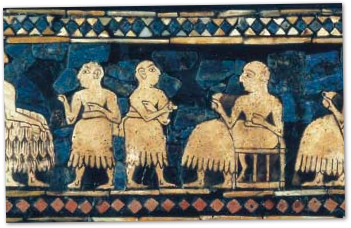









The Sumerians
We do not know where the Sumerian people originated or when they settled the lands north of the Persian Gulf. Language often provides a clue to a people's background, but it is of no help here. Sumerian is not related to any known tongue. The Sumerians probably entered Mesopotamia from the east, from the Zagros Mountains. They were attracted to southern Mesopotamia because the marshes along the rivers and the coasts of the Persian Gulf provided sources of food. They would have relied on a mixture of farming, herding, hunting, and gathering. Myths and archaeological evidence identify the town of Eridu near the later, more famous city of Ur, as one of the area's earliest settlements. It was inhabited by 5400 B.C.E.
During the first phase in Sumer's development, new kinds of settlements spread across the southern Mesopotamian plain. They were larger than Neolithic villages, and each boasted a major building, the construction and maintenance of which required a more sophisticated government than was characteristic of a simple village. Because all the dwellings in these communities were about the same size and there is little evidence of differences in wealth or of occupational specialization, privileged social classes may not yet have appeared. The investment that these communities made in their public buildings suggests, however, that this was changing. Their great buildings were probably temples, and temples created powerful priesthoods. Sumerian city states reached their full development between 3600 and 3000 B.C. Gilgamesh's Uruk (or Erech), for instance, grew by absorbing neighboring villages until it had about 50,000 inhabitants.
Scholars have wondered why Sumerian civilization quickly became dominated by cities in the 4th millennium B.C. At one time, they assumed that the development of irrigation systems promoted the growth of cities, but archaeological evidence suggests that the expansion of irrigation systems followed the rise of cities. Legends and archaeological evidence suggest that the Sumerians clustered together for protection. Cities were walled, and warfare appears to have been fairly commonplace as city states competed for land with their neighbors and neighboring peoples saw plenty in the river valleys and wanted to help themselves to some of it.
